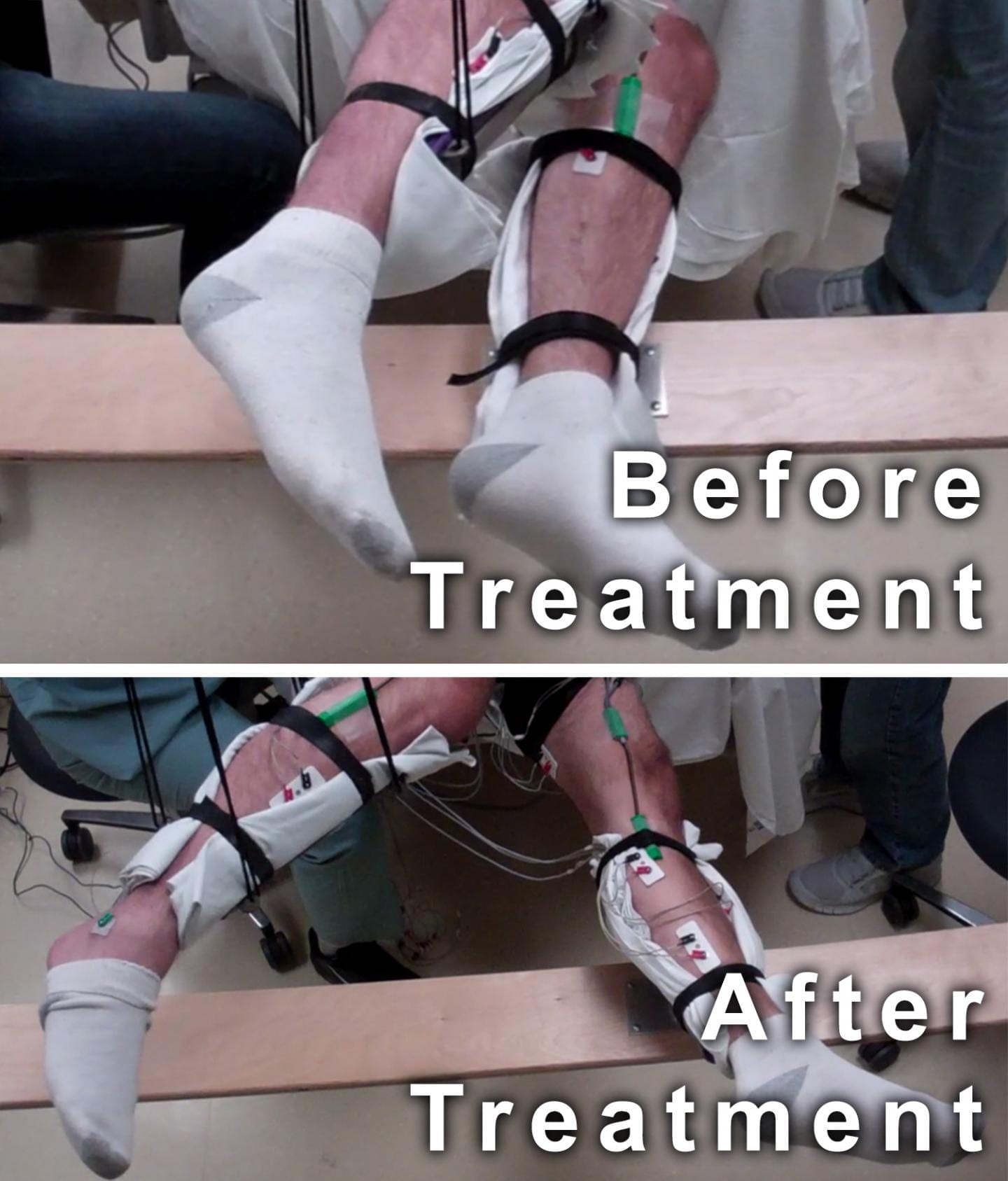
Researchers design cheap prosthetic knee that mimics normal walking motion
In the last two decades, prosthetic limb technology has grown by leaps and bounds. Today, the most advanced prostheses incorporate microprocessors that work with onboard gyroscopes, accelerometers, and hydraulics to enable a person to walk with a normal gait. Such top-of-the-line prosthetics can cost more than $50,000.
Amos Winter is aiming to develop a passive, low-tech prosthetic knee that performs nearly as well as high-end prosthetics, at a fraction of the cost.
“We’re going after this disruptive opportunity,” says Winter, an assistant professor of mechanical engineering at MIT. “If we can make a knee that delivers similar performance to a $50,000 knee for a few hundred dollars, that’s a game-changer.”
Now Winter and his colleagues have taken a significant step toward that goal. In a paper published in IEEE Transactions on Neural Systems and Rehabilitation Engineering, the team reports that it has calculated the ideal torque that a prosthetic knee should produce, given the mass of the leg segments, in order to induce able-bodied kinematics, or normal walking.
Using the paper’s results, the group has built a prototype of a prosthetic knee that generates a torque profile similar to that of able-bodied knees, using only simple mechanical elements like springs and dampers. The team is testing the prototype in India, where about 230,000 above-knee amputees currently live.
“In places like India, there’s still stigma associated with this disability,” Winter says. “They may be less likely to get a job or get married. People want to be incognito if they can.”
The paper’s co-authors include graduate student Murthy Arlekatti and Yashraj Narang, a PhD student at Harvard University.
Tuning torque
Most amputees in developing countries wear passive prostheses — simple, cheap designs with no moving parts. “When you see people walk in them, they have a pretty distinctive limp,” Winter says. In part, that’s because passive prostheses do not adjust the amount of torque exerted as a person walks. For instance, in normal walking, the knee flexes slightly, just before the foot pushes off the ground — a shift in torque that keeps a person’s center of mass steady. In contrast, a stiff, unbending prosthetic knee would cause a person to bob up and down with each step.
Winter reasoned that in order to produce a passive prosthetic knee that mimics normal walking, he would have to also mimic the changing forces, or torque profile, during normal walking. He and his team looked through the scientific literature for data on normal walking, and found a complete dataset that represented one person’s gait, including the angle of their joints, the weight of each leg segment, and the ground reaction force — the force between the ground and the foot — during a single step, or gait cycle.
The researchers used the measurements to calculate a torque profile — the amount of torque generated by the knee during normal walking. As prostheses are generally one-third to one-half as heavy as human legs and feet, the researchers adjusted the torque profile to apply to lighter leg segments.
“If you applied healthy levels of torque to a much lighter limb, your kinematics would get all screwed up,” Winter says. “Robotic limbs are designed to dial that torque back. Our challenge was, how do you tune the torque profile to get able-bodied motion, with a passive prosthetic knee?”
The researchers then looked at whether they could build a prosthetic knee to replicate the adjusted torque profile, using simple mechanical elements. Currently, the group has engineered a simple prototype that includes a spring and two dampers that act as brake pads. The spring allows the knee to bend just before the foot pushes off the ground. At the same time, the first damper engages to prevent the leg from swinging back. The second damper engages as the leg swings forward, in order to slow it down just before the heel strikes the ground.
Winter’s team is now testing the design with volunteers in India.
Read more: A cheaper, high-performance prosthetic knee
The Latest on: High-performance prosthetic knee
[google_news title=”” keyword=”High-performance prosthetic knee” num_posts=”10″ blurb_length=”0″ show_thumb=”left”]
via Google News
The Latest on: High-performance prosthetic knee
- Robotic knee replacements improve outcomes, cost more: Studyon May 8, 2024 at 10:09 am
While total knee replacements performed with the help of surgical robots have better patient outcomes, they cost an average of $2,400 more than conventional knee replacements, according to new ...
- High-performance artificial muscles made from pure conductive polymer fiberson May 3, 2024 at 5:01 pm
(Nanowerk Spotlight) Artificial muscles hold the promise of revolutionizing fields ranging from robotics and prosthetics ... high manufacturing costs. Carbon nanotubes have emerged as a leading ...
- Runway Feet Prosthesis from Freedom Innovationson May 1, 2024 at 5:00 pm
Amputees greatly value the versatility offered by the Runway adjustable heel height prosthetic foot ... foot alignment to provide knee stability and consistent performance at all heel heights.
- Is There a Best Knee Replacement Implant? What to Know When Choosingon May 1, 2024 at 5:00 pm
Today, there’s no shortage of manufacturers producing prosthetic devices for knee replacements ... Replacement Registry for a database on the performance of different joint implants.
- Prosthetic Joint Infectionon April 30, 2024 at 5:00 pm
A recent meta-analysis on the diagnostic performance of antigranulocyte scintigraphy included 13 studies with a total sample size of 522 prostheses and reported estimates of sensitivity and ...
- high performance computingon April 21, 2024 at 5:00 pm
It was designed to put high performance computing in a small and energy efficient enough package that it could be integrated directly into products, rather than connecting to a data center half ...
- Local Infections After Above-Knee Prosthetic Femoropopliteal Bypass for Intermittent Claudicationon April 18, 2024 at 5:00 pm
Background: The use of prosthetic grafts in the treatment of ... Conclusions: The present series had a high frequency of graft infections. Our data suggest that a selective approach should be ...
- Executive 360on December 18, 2020 at 3:47 am
Executive 360 is a comprehensive health evaluation designed for high-performance individuals. When it comes to health, peace of mind comes from thoroughness and precision. Executive 360 is a ...
- High Performanceon July 23, 2020 at 11:46 pm
The overall sales trajectory, therefore, resembles an S. High-performance businesses—the ones that consistently lead their industries over many business cycles—jump from one S-curve to another ...
- Clinical Outcomes and Statistics of Knee Replacementon April 14, 2020 at 5:00 pm
involves resurfacing the worn-out surfaces of the knee joint with a prosthetic device that carries out the same functions as your knee. Every year in the United States, surgeons carry out ...
via Bing News










